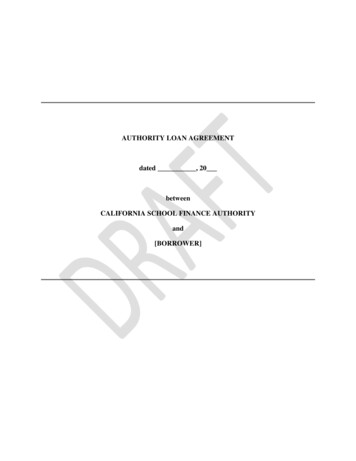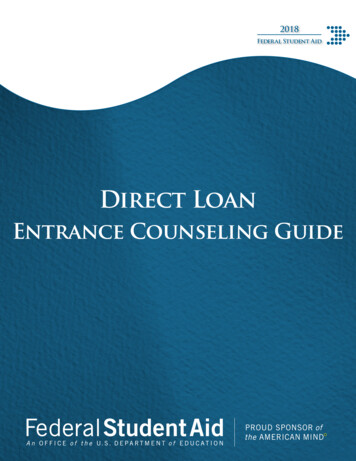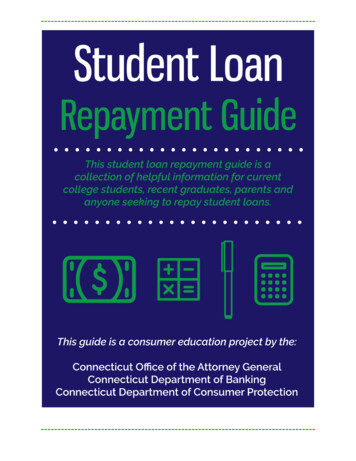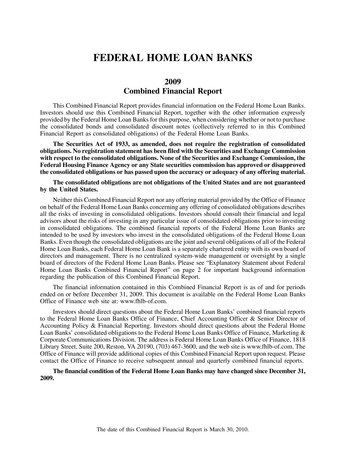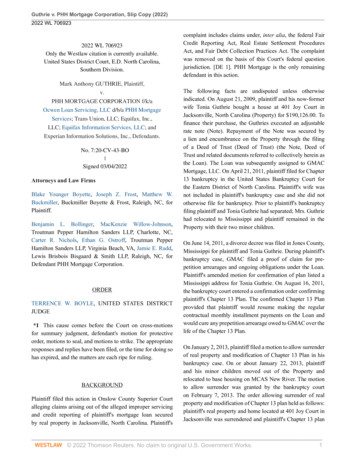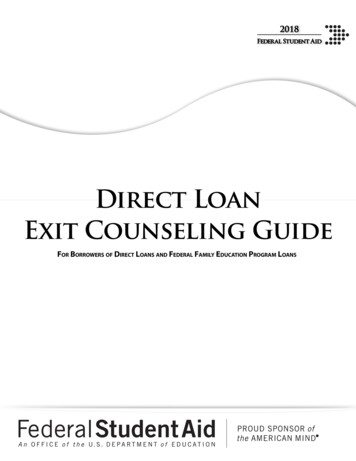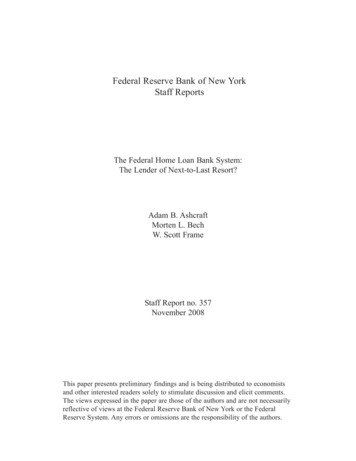
Transcription
F E D E R A L R E S E R V E B A N K O F AT L A N TAThe Federal Home LoanBank System: The “Other”Housing GSEMARK J. FLANNERY AND W. SCOTT FRAMEFlannery is the Bank of America Professor of Finance at the University of Florida inGainesville. Frame is a financial economist and associate policy adviser in the AtlantaFed’s research department. They thank Gerald Dwyer, David Feldhaus, Richard Fritz,William Jackson, Christopher McEntee, Joseph McKenzie, Wayne Passmore, Steven Patrick,and Larry Wall for comments on an earlier draft. The authors also thank Stella Lang at theFederal Home Loan Bank of Atlanta, staff at the Federal Home Loan Banks Office ofFinance, and Ellen Hancock and Joseph McKenzie at the Federal Housing Finance Boardfor helpful background information, and Brandon Lockhart for valuable research assistance.he federal government has played an active role in residential mortgage financesince the Great Depression.1 Prior to that time, mortgages typically had shortterms (often less than five years), carried variable rates, and required final “balloon”payments that were generally refinanced. In the early 1930s residential real estatevalues (and financial asset values generally) fell dramatically. Coupled with limitedrefinancing opportunities, this decline generated a wave of mortgage defaults andforeclosures, further depressing the housing market. The federal governmentresponded to this crisis by creating several financial institutions to promote the useof long-term, fixed-rate, fully amortizing residential mortgages. The first of these newinstitutions was the Federal Home Loan Bank System (FHLB System), which wascreated in 1932 as a collection of cooperatively owned wholesale banks.Historically, the twelve Federal Home Loan Banks (FHLBs or Banks) primarilyacted as a reliable provider of long-term funding to specialized mortgage lenders.Specifically, the Banks made (over)collateralized loans, known as “advances,” to thriftinstitutions and a few insurance companies. While the advance business has endured,the FHLB System has evolved since the resolution of the 1980s thrift crisis.The Financial Institutions Recovery and Reform Act of 1989 (FIRREA) includedtwo provisions that precipitated lasting changes for the FHLBs. First, the law openedFHLB membership to all depository institutions with more than 10 percent of theirportfolios in residential mortgage-related assets. This change allowed many commercial banks and credit unions to join the FHLB System for the first time.Membership increased from 3,200 to more than 8,000 between 1989 and 2005despite the declining number of federally insured thrifts, which were legally requiredto be FHLB members until 1999. The transition from mandatory to voluntary FHLBmembership also arguably forced the Banks to become more attuned to their members’ desire for attractive advance rates and dividend payments. Second, FIRREAimposed “income taxes” on the individual FHLBs. They must now pay 20 percent ofTECONOMIC REVIEWThird Quarter 200633
F E D E R A L R E S E R V E B A N K O F AT L A N TAnet earnings to cover a portion of the interest on the Resolution Funding Corporation(REFCORP) bonds used to finance the thrift cleanup; another 10 percent is set asidefor low- and moderate-income housing programs.The statutory changes in FIRREA encouraged the FHLB System to grow and toincrease its attention to profitability. Between 1989 and 2005 FHLB System totalassets increased from about 175 billion to 1 trillion, and its composition of assetsFinancial economists recognize that publicchanged. Besides a secular increase inguarantees of a private firm’s debts canadvances, FHLB balance sheets have alsocome to include substantial investment inlead the insured firm to take greater risksmarketable securities (especially mortgagethan it otherwise would.backed securities) and member-guaranteedmortgage pools. This shift, in turn, hasresulted in the Banks managing an increasing amount of interest rate risk, includingthe embedded call options associated with mortgage prepayment.The FHLBs’ growth and profitability trends have been further reinforced by theadvances in information technology and financial practice that contributed to financial services consolidation. Even though they are the largest users of FHLB advances,the very largest U.S. depository institutions maintain regional or nationwide branchnetworks and access to various other wholesale borrowing mechanisms. Furthermore,many of these institutions maintain charters in more than one Bank district, therebyallowing for multiple channels into the FHLB System. These trends have served toheighten competitive pressures within the cooperative and suggest that the FHLBadvances are but one of many different sources of nondeposit funding. While theFHLB System has grown in size, complexity, and risk over time, very little researchhas been published about this institution.2A government-sponsored enterprise (GSE) is a financial institution charteredby Congress but owned by private shareholders (cooperative members or outsideinvestors, depending on the ownership arrangement). Today three GSEs serve housing (the FHLB System, Fannie Mae, and Freddie Mac), and two others serve agriculture(the Farm Credit System and Farmer Mac).3 GSE debt securities are commonlydescribed as “U.S. agency” obligations, which are perceived by investors to be implicitly guaranteed by the U.S. government despite explicit, legally prescribed denials inoffering materials. Financial economists recognize that public guarantees of a privatefirm’s debts (either explicit or implicit) can lead the insured firm to take greater risksthan it otherwise would (“moral hazard”).4 This moral hazard, in turn, imposes apotential cost on taxpayers in the event of financial distress.The public has recently learned of several significant financial or accountingproblems at housing GSEs. In 2002 Fannie Mae disclosed a significant exposure tointerest rates as measured by their “duration gap.”5 The following year the GSEs’ regulator, the U.S. Office of Federal Housing Enterprise Oversight (OFHEO), found thatFreddie Mac had engaged in questionable accounting practices that allowed the company to manage its earnings by deferring 5 billion of income into future years.6 Mostrecently OFHEO determined that Fannie Mae inappropriately applied hedgeaccounting rules and misclassified assets, overstating its equity by 10.8 billion.7Problems have also arisen within the FHLB System during this time. Standard &Poor’s has downgraded derivative counterparty ratings for three FHLBs (Chicago,New York, and Seattle) from AAA to AA and currently maintains a “negative outlook” on six FHLBs (Chicago, Dallas, Des Moines, Indianapolis, Pittsburgh, andSeattle).8 In all but one instance (New York), the downgrades and outlook changes34ECONOMIC REVIEWThird Quarter 2006
F E D E R A L R E S E R V E B A N K O F AT L A N TAwere triggered by concerns about individual FHLBs’ ability to manage their interestrate risk exposures.The troubles experienced by some FHLBs came as a surprise to many observerssince cooperatives and mutuals are often viewed as less risky than stock-ownedfirms. Perhaps more precisely, the operation and incentives of cooperative firms areless well understood than those of traditional firms. Recent testimony by formerFederal Reserve Board Chairman Alan Greenspan (2004), for example, noted thatthe FHLBs are more “complex to analyze than other GSEs and hence raise additional issues.”The principal contribution of this article is to identify and analyze differences inthe FHLBs’ risk-taking incentives vis-à-vis those for Fannie Mae and Freddie Mac. Webegin by characterizing housing GSEs generally and then examine the structure,activities, and risks of the FHLB System in particular.Housing GSEsThe history of U.S. housing GSEs began during the Great Depression with the creation of the FHLB System in 1932. That system has operated for nearly seventy-fiveyears with essentially the same corporate structure (described below). The NationalHousing Act of 1934 then created the Federal Housing Authority (FHA) to operate amortgage insurance program; the act also provided for the chartering of nationalmortgage associations as entities within the federal government. The only associationever formed was the National Mortgage Association of Washington in 1938, whicheventually became the Federal National Mortgage Association (Fannie Mae). In 1968Fannie Mae was converted into a private corporation, with publicly traded shares listedon the New York Stock Exchange (NYSE). Freddie Mac was chartered by Congressin 1970 to securitize mortgages originated by thrifts. During the 1970s and 1980s,Freddie Mac was technically a private company although its equity shares were held1. For a discussion of the development of U.S. mortgage markets since the 1930s, see, for example,Quigley (2005) and Green and Wachter (2005).2. An EconLit search uncovered seven published academic articles primarily concerning the operationof the FHLB System itself: Silber (1973), Jaffee (1976), Goldfeld, Jaffee, and Quandt (1980), Mays(1989), Hoffman and Cassell (2002), Frame (2003), and Nickerson and Phillips (2004).3. The Student Loan Marketing Association (Sallie Mae) is also a GSE serving education, but it is inthe process of privatization under the name SLM Corporation.4. This moral hazard may also allow the guaranteed firm to grow abnormally large. In the case ofhousing GSEs, their large scale has resulted in systemic risk concerns as the institutions havebecome the central players in the U.S. housing finance system and markets for certain U.S. dollarinterest rate derivatives.5. Duration gap is the difference between the weighted-average duration of assets and the weightedaverage duration of liabilities for a given change in interest rates. Frame and White (2004) providea brief summary of Fannie Mae’s duration gap episode while Jaffee (2003) provides greater detailon the practice of interest rate risk management at both Fannie Mae and Freddie Mac.6. See Baker-Botts LLP (2003) for a detailed discussion of the questionable financial transactions andan evaluation of their treatment under generally accepted accounting principles. Baker-Botts wasretained by the board of directors of Freddie Mac. See U.S. OFHEO (2003) for the supervisoryanalysis of these issues.7. Kopecki (2005) reports an estimated cumulative after-tax write-down of 10.8 billion for the2001–04 period. See U.S. OFHEO (2004) and Paul, Weiss, Rifkind, Wharton, and Garrison LLP(2006) for discussions of the problems with Fannie Mae’s accounting policies, internal controls,and financial reporting processes.8. Moody’s has neither downgraded any FHLBs nor placed any of the institutions under a “negativeoutlook.”ECONOMIC REVIEWThird Quarter 200635
F E D E R A L R E S E R V E B A N K O F AT L A N TAThe Housing GSEs’ Federal Chartersongress has bestowed some benefits on thehousing GSEs that result in lower costs. Interms of operating costs, the three housing GSEsare exempt from paying state and local corporateincome taxes and are not required to registertheir debt and mortgage-backed securities issueswith the Securities and Exchange Commission(SEC).1 Several other features of the GSE charters cumulate to much larger savings by loweringthe housing GSEs’ funding costs.The markets appear to believe that the GSEs’obligations carry an implicit federal guaranty.Why? First, the U.S. Treasury is authorized to purchase housing GSE securities up to 2.25 billionfor both Fannie Mae and Freddie Mac and up to 4 billion for the FHLB System. Second, housing GSE securities are considered governmentsecurities under the Securities and ExchangeAct of 1934 (hence their exemption from registration). This status means that housing GSEsecurities can be used as collateral for publicdeposits, can be bought and sold by the FederalReserve in open market operations, and may beheld in unlimited amounts by federally insureddepository institutions. Third, housing GSEsecurities are eligible for issuance and transfer through the Federal Reserve System’s bookentry system, the same used by the U.S. Treasury.Finally, housing GSEs are not subject to thebankruptcy code since they are considered toCbe “federal instrumentalities.” No resolutionmechanism has been specified in the event thatone of these firms fails, and hence congressionalaction would be required.2 This action is unlikelyto occur quickly.The housing GSEs’ federal charters alsoimpose some important limitations. First, theactivities of each institution are largely limited toresidential mortgage finance. Fannie Mae andFreddie Mac securitize and invest in only “conforming” mortgages (or securities backed bysuch mortgages) or those below 417,000 for2006; the FHLBs make advances collateralized(almost exclusively) by mortgages or investmentsecurities and invest in mortgages and mortgagebacked securities. Second, each housing GSEhas certain social obligations. For example, in2006, 53 percent of Fannie Mae’s and FreddieMac’s business must benefit low- and moderateincome families, 38 percent must benefit underserved areas, and 23 percent must serve “specialaffordable” needs. The FHLBs contribute at least10 percent of their net earnings to low- andmoderate- income housing programs and arealso responsible for paying interest on the REFCORP bonds that were issued in the early 1990sto resolve the savings and loan crisis. Finally, allthree housing GSEs are subject to safety-andsoundness oversight, which may entail furtherrestrictions on their scale or activities.1. Until recently none of the housing GSEs registered their equity securities with the SEC. Fannie Mae and FreddieMac volunteered to do so in July 2002 although only Fannie Mae, to date, has followed through on that commitment, registering in March 2003. In 2004 the Finance Board required each FHLB to register its equity with theSEC—a process that should be completed by the end of 2006.2. In the case of Fannie Mae and Freddie Mac, their federal safety-and-soundness supervisor (OFHEO) does nothave receivership authority. By contrast, as noted by Carnell (2005), the Finance Board has broad authority toliquidate or reorganize any Federal Home Loan Bank (12 U.S.C. 1446).solely by the twelve FHLBs and their thrift members.9 Freddie Mac was convertedinto a publicly traded company in 1989, with its shares listed on the NYSE.Each of the three housing GSEs operates under its own federal charter, whichboth limits its permissible activities and bestows several institutional benefits (seethe sidebar above). The most valuable of these benefits arises from the financial markets’ perception that the federal government implicitly guarantees housing GSE obligations. As a result, GSE senior debt obligations are rated AAA even though theirstand-alone ratings would be lower.10 The implicit guaranty allows the GSEs to borrow36ECONOMIC REVIEWThird Quarter 2006
F E D E R A L R E S E R V E B A N K O F AT L A N TAat favorable interest rates and then pass some of these savings on to their customers.Hence, by chartering a specific GSE, the federal government can target benefitstoward a specific sector of the economy without recognizing the attendant opportunity costs in the federal budget.11 However, potential costs remain if Congress wereto provide support to an insolvent GSE. In the late 1980s, for example, the FarmCredit System received a 4 billion taxpayer bailout.12The market’s perception of an implicit guaranty of housing GSE obligations distortsthe institutions’ risk-taking incentives in a way that may increase the probability of financial distress. A similar situation is well understood in the context of federally insureddepository institutions. The idea is that a federal guaranty induces bondholders (depositors) to accept artificially low (perhaps even risk-free) promised interest rates regardless of an institution’s true risk of default. GSEs and insured depositories can thenincrease the riskiness of their activities—which promise high shareholder returns if therisks turn out well—without needing to share those rewards with liability holders in theform of higher coupon rates on their debt (deposits or bonds). The firms’ equity holders thus perceive a greater-than-normal benefit from risk taking, and their investmentdecisions can distort capital flows and decrease the expected benefits of financial intermediation in the economy. If this increase in risk occurs, taxpayers effectively subsidizethe equity holders of GSEs and insured depository institutions.It is important to recognize that insured entities need not explicitly decide toincrease their risks. Such a move could be inadvertent. For example, growing businesses often do not improve their infrastructure as quickly as they raise new revenues.If the creditors of a fully private firm felt that its risk-management systems hadbecome inadequate, they could pressure the firm to improve those systems. If thefirm failed to respond, its bond and stock prices would fall, raising the possibility ofa hostile takeover. Federally guaranteed firms, by contrast, do not benefit from thismarket discipline, through which outsiders’ concerns about such errors of omissioncan be expressed. If the federal guaranty is considered sufficiently strong, bondclaimants may not bother to examine the firm’s infrastructure.The federal government recognizes these potential moral hazards and has createdsafety-and-soundness regulators to limit potential taxpayer exposure. Fannie Mae andFreddie Mac are regulated by OFHEO, an independent agency within the U.S.Department of Housing and Urban Development (HUD).13 The FHLB System isoverseen by the Federal Housing Finance Board (Finance Board), an independent9. Moreover, Freddie Mac’s board of directors consisted of the three board members of the FHLBBoard, which regulated the FHLBs and the thrift industry during that time.10. Fannie Mae and Freddie Mac receive AA– ratings from Standard and Poor’s in terms of their riskto the government. However, such ratings incorporate whatever government support or intervention the entity typically enjoys during the normal course of business. See Frame and Wall (2002)for a discussion. Those two GSEs also receive “bank financial strength” ratings from Moody’s (onan A–E scale), which are B (Fannie Mae) and A– (Freddie Mac).11. The appendix to the federal budget, however, discusses each of the five GSEs and provides basicinformation about their mission, history, and financial condition. Although additional costs resultfrom resource misallocations in the real sector, such costs are not recognized in the budget.12. The U.S. General Accounting Office (GAO) (1990, 90–91) discusses this episode as well as onein the late 1970s, when Fannie Mae was insolvent on a market-value basis and benefited fromsupervisory forbearance.13. OFHEO was created by the Federal Housing Enterprises Financial Safety and Soundness Act of1992. Prior to 1992 HUD maintained exclusive regulatory oversight responsibilities for FannieMae and (for 1989–92) Freddie Mac. HUD continues to act as the mission regulator of the twoinstitutions. Before FIRREA’s passage Freddie Mac was the responsibility of the FHLB Board.ECONOMIC REVIEWThird Quarter 200637
F E D E R A L R E S E R V E B A N K O F AT L A N TATable 1Federal Home Loan Bank System Combined Balance Sheet as of March 31, 2006AssetsAdvancesMortgage loans (net)InvestmentsMortgage-backed securitiesFederal agency securitiesOther investment securitiesFederal fundsInterest-bearing depositsReverse repurchase agreementsOther assetsTotal assetsLiabilities and capitalConsolidated obligations (net)Other liabilitiesMembership capital stockRetained earningsOther comprehensive incomeTotal liabilities and capitalDollars(in millions)Percentof .04.20.30.01,003,783100.0Source: Federal Housing Finance Boardagency within the executive branch.14 Each regulator is authorized to set risk-basedcapital standards, conduct examinations, and take certain enforcement actions ifunsafe or unsound practices are identified. Nevertheless, both regulatory agencieshave been criticized for their alleged ineffectiveness.15Ironically, federal supervision of the GSEs may encourage investors’ faith in a federal guaranty, despite the government’s and the GSEs’ explicit disavowals. As a theoretical matter, it is unclear whether the presence of these safety-and-soundness regulatorsincreases or decreases expected taxpayer exposure (Frame and White 2004).Structure, Activities, and Risks of the FHLB SystemThe FHLB System includes twelve regional wholesale Banks and an Office of Financethat acts as the FHLBs’ gateway to the capital markets.16 Each Bank is a separatelegal entity, cooperatively owned by its member financial institutions, and has its ownmanagement, employees, and board of directors. Historically, the individual FHLBsdid not compete for members. Each Bank is assigned a distinct geographic area, within which it tries to attract members by offering various credit products, investmentproducts, payments services, and custody services.17 The FHLB System is oftenviewed as a whole because most Bank financing takes the form of debt for which thetwelve Banks are jointly and severally liable.Table 1 presents a combined balance sheet for the FHLB System as of March 31,2006.18 The largest asset category is member advances ( 615 billion, or 61.2 percent38ECONOMIC REVIEWThird Quarter 2006
F E D E R A L R E S E R V E B A N K O F AT L A N TAof total assets), which constitute the primary avenue by which the FHLBs may support housing and community development. Advances are available in various maturities, carry fixed or variable rates of interest, sometimes contain embedded options,and are fully collateralized. In terms of maturities, as of March 31, 2006, 39.8 percentof advances were due in less than one year, 46.6 percent were due in one to fiveyears, and 13.6 percent were due thereafter. Put and call options that can alterThe troubles experienced by some FHLBsthe duration and yield of an advance werecame as a surprise to many observers sinceincluded in 21.2 percent of the Banks’combined advance book at the end of thecooperatives and mutuals are often viewedfirst quarter of 2006.19 The most commonas less risky than stock-owned firms.forms of advance collateral are mortgagerelated assets (whole loans and mortgagebacked securities) and U.S. Treasury and federal agency securities.20 Beyond theirexplicit collateral, the FHLBs also have priority over the claims of depositors andalmost all other creditors in the event of a member’s default (12 U.S.C. 1430[e]).21 NoFHLB has ever suffered a credit loss on an advance.Each FHLB maintains a portfolio of investments, which on a combined basistotaled 279 billion at the end of the first quarter of 2006. For liquidity, the FHLBshold 124.4 billion in short-term investments, such as federal funds and certificatesof deposit, issued by highly rated institutions. The Banks also hold longer-terminvestments to enhance interest income ( 154.6 billion), especially residential mortgagebacked securities.The FHLB System’s combined balance sheet has come to include a substantialproportion of residential mortgages (10.3 percent) since the introduction of the ChicagoFHLB’s Mortgage Partnership Finance Program in 1997. The Banks now purchase14. The Finance Board was established by FIRREA in 1989 as the regulator of the FHLB System,thereby replacing the FHLB Board. A five-member board of directors governs the Finance Board;the president appoints four full-time members with the advice and consent of the Senate forseven-year terms, designating one of the four as chair. The secretary of HUD is the fifth member.15. For example, U.S. Treasury Secretary Snow (2003) testified before Congress that there is a “general recognition that the supervisory system for the housing GSEs neither has the tools, nor thestature, to effectively deal with the current size, complexity, and importance of these enterprises.”16. The twelve FHLBs are located in Atlanta, Boston, Chicago, Cincinnati, Dallas, Des Moines,Indianapolis, New York, Pittsburgh, San Francisco, Seattle, and Topeka. The Office of Finance islocated in Reston, Virginia.17. The specific products and services offered by the individual FHLBs can often be found on theirrespective Web sites. Visit www.fhfb.gov/FHLB/FHLBS banks.htm for links to all twelve FHLBsand a list of states served by each individual Bank.18. This information was provided by the Finance Board. Audited financial statements for the combined FHLB System are unavailable pending the completion of each Bank’s registration with theSecurities and Exchange Commission.19. Putable advances, which provide the FHLB with an option to require the borrower to repay onprespecified exercise dates before maturity without a fee, made up 16.6 percent of advances. TheAtlanta and New York FHLBs together account for more than half of putable advances outstanding.Callable advances, which provide the member with an option to prepay on prespecified exercisedates, made up 4.6 percent of advances. The Cincinnati Bank is responsible for three-quarters ofthese loans.20. See 12 U.S.C. 1430(a)(3) for a complete list of eligible collateral. Federal agency securities aregenerally synonymous with debt and mortgage-backed securities issued by GSEs.21. Bennett, Vaughan, and Yeager (2005) describe how FHLB advances may increase the probabilityof bank default and raise the FDIC’s expected losses given default.ECONOMIC REVIEWThird Quarter 200639
F E D E R A L R E S E R V E B A N K O F AT L A N TATable 2Federal Home Loan Bank Holdings of Mortgages and MBS as of March 31, 2006Mortgages(millions of dollars)MBS(millions of dollars)Mortgages MBS(millions of dollars)Mortgages MBS(percent of assets)AtlantaBostonChicagoCincinnatiDallasDes MoinesIndianapolisNew YorkPittsburghSan 12.4023.1914.1525.4817.49FHLB System103,537124,364227,90122.70Source: Federal Housing Finance Boardconforming fixed-rate mortgages on single-family properties from participating member institutions under several distinct programs.22 Roughly speaking, the seller guarantees most of the mortgages’ credit risk, while the interest rate risk is borne by theFHLBs (Frame 2003). This mortgage-related interest rate exposure is reinforced bysubstantial FHLB holdings of mortgage-backed securities (MBS). Table 2 shows thatnearly one-quarter of FHLB System assets were mortgage related at the end of thefirst quarter of 2006: 103.5 billion in whole mortgages plus 124.4 billion in MBS. Alltwelve FHLBs invest more than 12 percent of their asset portfolios in mortgage-relatedassets. The largest concentrations are the Chicago (56.0 percent), Des Moines (40.4 percent), and Indianapolis Banks (34.4 percent).The FHLB asset portfolios are largely funded with debt, almost all of which takesthe form of “consolidated obligations” issued by the Office of Finance and for whichthe twelve Banks are jointly and severally liable. As of March 31, 2006, the FHLBSystem had 918.2 billion in consolidated obligations outstanding. Discount notes(maturities up to one year) represented 17.1 percent of consolidated obligations, andbonds (maturities almost exclusively between one and ten years) the remaining 82.9percent. The FHLB System also maintained 45.3 billion in equity capital at that time(4.5 percent of total assets). Member stock subscriptions are the dominant form ofequity, making up 94 percent of total FHLB System equity. History can readily explainthe unusually small contribution of retained earnings to total capital: Congress previously took the Banks’ retained earnings to help pay for the thrift bailout. Thereafter theFHLBs began to pay out almost all earnings as dividends. The Financial ModernizationAct of 1999 clarified that a particular class of FHLB shareholders would legally ownthe institutions’ retained earnings (as well as surplus, undivided earnings, and equityreserves) going forward.23The FHLBs face little credit risk in their asset portfolios. As shown in Table 2,however, they hold substantial amounts of mortgage-related assets. The interest raterisk from these assets requires careful treatment because changes in interest ratesinfluence borrower prepayment behavior, which in turn has implications for the40ECONOMIC REVIEWThird Quarter 2006
F E D E R A L R E S E R V E B A N K O F AT L A N TAexpected life of mortgage assets. For example, when interest rates rise, mortgageinvestors experience losses in value because they are holding fixed-rate debt instruments yielding a below-market rate of return, and the duration of the asset increasesbecause of lower expected borrower prepayments. In a falling-rate environment, thenormal value gains associated with holding fixed-rate debt instruments are reducedby an associated increase in expected prepayments. This phenomenon of additionaladverse effects on mortgage investors from decreases or increases in interest rates isoften described as the “negative convexity” of the mortgage instrument.Callable bonds provide one important and straightforward way for the FHLBs tohedge mortgage-related interest rate risk.24 By issuing callable bonds, if interest ratesfall and mortgages prepay, the Banks can replace their higher-cost bonds with new onesbearing a lower rate of interest. The Banks also regularly use interest rate derivativesto transform their liability maturities and to hedge some of the negative conv
institutions was the Federal Home Loan Bank System (FHLB System), which was created in 1932 as a collection of cooperatively owned wholesale banks. Historically, the twelve Federal Home Loan Banks (FHLBs or Banks) primarily acted as a reliable provider of long-term funding to specialized mortgage lenders.


